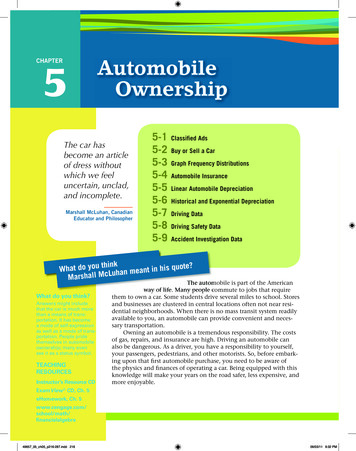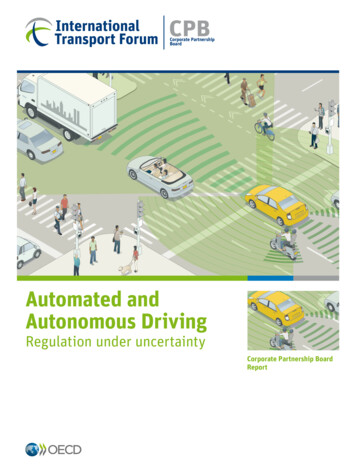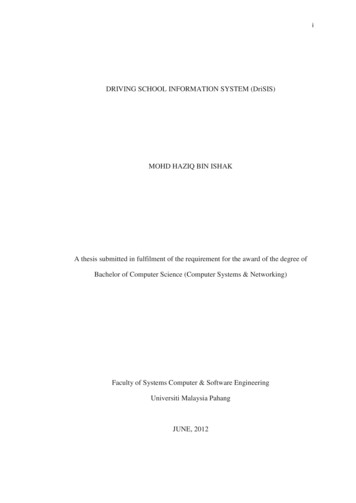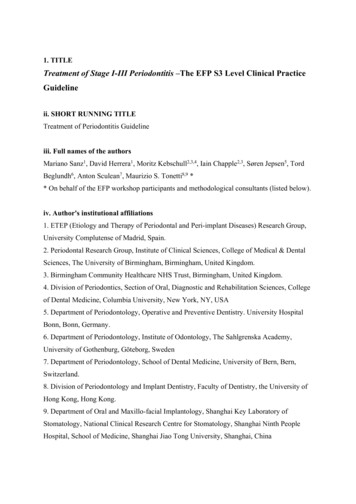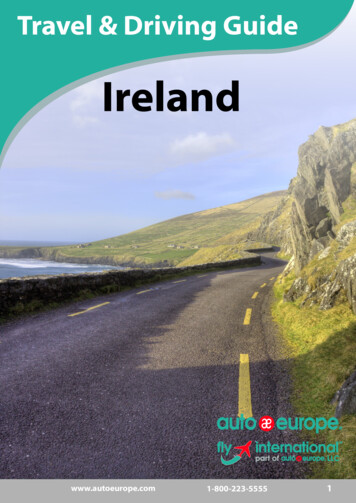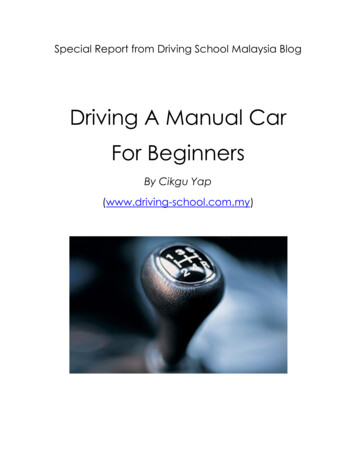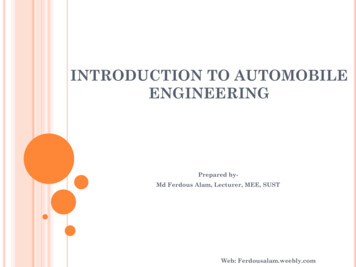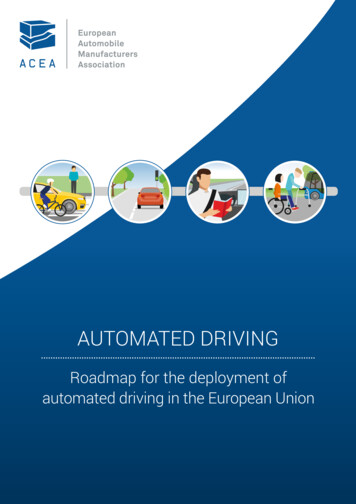
Transcription
AUTOMATED DRIVINGRoadmap for the deployment ofautomated driving in the European Union
WHAT IS AUTOMATED DRIVING?There are different levels of automated driving, startingwith technology that assists drivers in the steering,acceleration and/or braking of their motor vehicle andgoing up to levels that completely substitute the humandriver by a system. At the highest level of automation, thevehicle is equipped with technology that makes it able tosense and interpret its environment, make vehicle controldecisions, and react without relying on the human driver.Automated vehiclesare equipped with technology that enables them to:360 React withoutSense andinterpretrelyingon the their environmenthuman driverMake vehicle control decisionsReact without r elyingon the h uman driverWHAT ARE THE LEVELS OF AUTOMATED DRIVING?Today, there are already several systems on the market withdifferent levels of automation. These can be considered asthe building blocks towards driverless cars.Assisted driving includes basic systems that recommendactions to drivers or give them additional sensorial perception(eg blind spot detection), while advanced active safety systemsintervene automatically, faster and more reliably than a humanbeing. Examples of the latter are autonomous emergencybraking (AEB) and lane keeping assistance (LKA) systems thattake over safety-critical functions in dangerous situations.Automated driving technology is able to perform alldynamic driving tasks in specific scenarios. Think forexample of an autopilot function for driving on motorways,which can be activated by the human driver to performdriving tasks, including overtaking and changing lane.Finally, the goal of autonomous driving is that the vehiclecan handle the full driving experience, including departureand arrival at the destination, without the need for any inputfrom the passenger.ASSISTED DRIVINGThe driver is at the wheel and must constantly supervise the vehicle and intervene when necessary. The system provides steering, acceleration and braking support.AUTOMATED DRIVINGsystem is able to cope with all dynamic driving tasks within its operational design domain The(ODD) without driver supervision.will transition to the driver, offering sufficient lead time, when these conditions are not met. ItThe driver may perform non-driving related tasks. The driver must be promptly available for safe transition of control.AUTONOMOUS DRIVINGsystem drives the vehicle under all conditions. Thedriver input is required. NoAllvehicleoccupants are effectively passengers.
WHAT ARE THE BENEFITS OF AUTOMATED DRIVING?Automated driving is one of the major technological advancements that is changing how we travel and transport goods – it isreshaping the future of mobility in Europe. When fully integrated in the whole transport system and accompanied by the rightsupporting measures, automation is expected to contribute significantly to achieving the following four social objectives:ROAD SAFETYAutomated driving is expectedto greatly reduce the riskof human error in driving,thereby making an importantcontribution to the EU goal ofzero road fatalities by 2050.ACCESSIBILITY ANDSOCIAL INCLUSIONIt will be beneficial for peoplewith reduced mobility, suchas the elderly and disabled,providing them with new mobilitysolutions and increased accessto healthcare, work, city centresand remote locations.EFFICIENCY ANDENVIRONMENTIt will reduce traffic congestionand increase the efficiency of ourtransport system, contributing toa decrease in fuel consumptionand emissions (thus alsoaddressing climate change andimproving air quality).FREEDOM AND COMFORTAutomation will increase thefreedom of drivers,by allowing them to performother activities when automatedsystems are active.HOW DO WE GET THERE?Before automated vehicles can become a common sight on our roads, Europe needs to:research and development into automated driving Continue performing large-scale and cross-border testing Fostertechnologies and standards.of automated systems on open roads across the EU.R s Strengthencooperation between all stakeholders and get to create the right legal framework for deployment. political supportto promote its wide-scale introduction. Upgrade,adaptandharmonisephysicalanddigitalroad Informandeducatethe general public as well as future infrastructure to make it suitable for automated driving. drivers and passengersof automated vehicles.Vehicle manufacturers will: Further develop automated driving technology and itspractical applications. the necessary technical expertise to support the Provideregulatory process.HOW CONNECTIVITY ENHANCES AUTOMATED DRIVINGVehicle connectivity is all about the exchange of information between vehicles which are in closeproximity to each other, the infrastructure around them and the wider world. It is an importantenabler for many automated driving functionalities and for improving active safety features andadvanced driver assistance systems (ADAS).Connectivity also brings additional sensorial capabilities, notably enabling the detection ofhazardous situations that are out of direct range of the vehicle’s sensors, for example around cornersor further down the road.Crucially, connectivity provides vital control functionalities for certain automation applications, such astruck platooning (the linking of two or more trucks in convoy using connectivity technology and ADAS).
ROAD SAFETYAutomated driving holds great potential to further improve safety on our roads. Indeed, many of today’s active safetytechnologies (which prevent accidents from happening altogether or at least actively help the driver to reduce the impact of anemergency situation) are already starting to prepare drivers and other road users for a future when vehicles will drive themselves.HOW AUTOMATION AND CONNECTIVITY WILL FURTHER IMPROVE SAFETYASSISTED DRIVINGAUTOMATED DRIVINGToday, we already see theintroduction of partially automatedvehicles, able to perform anincreasing range of driving tasksin specific LANEKEEPINGLANEKEEPINGThese vehicles have the abilityto navigate without permanentsupervision from the NECTIVITYExchanging safety-critical informationbetween vehicles and infrastructuremakes it possible to reduce thenumber of accidents and �mbraking!”I’mI’mbraking!”braking!”360 360 360 360 360 360 Using this information it is possible to:Including active safety systems thatintervene in dangerous GReduces the risk of human errorin driving, which is still a majorcontributing factor in most DAHEADRESEARCH AND DEVELOPMENTThe European automotive sector spends 57.4 billion onresearch and development per year, making it the EU’snumber one investor in R&D, responsible for 28% of totalspending. Automation is one of the most important driversof innovation in the auto industry, making it is a decisivefactor in the future viability of the sector in Europe.Indeed, research and pre-deployment projects focussing onautomated driving give a strong boost to the technologicalcompetitiveness of auto manufacturers, helping the industryto maintain its position as an engine for growth and jobs.4 KEY FOCUS AREASSECURITYUSER ADOPTIONARTIFICIALINTELLIGENCETESTINGIt is essential to guaranteesafe, secure and trustedcommunication betweenvehicles and the digitalinfrastructure.The success of automateddriving depends on useradoption as well asacceptance by societyat large, including otherroad users.AI enables safeautonomous drivingin a complex trafficenvironment. It also playsa major role in intelligentmobility services.Large-scale testing andvalidation of automateddriving systems on openroads is vital to furtheringtheir development anddeployment.
SHAPING TOMORROW’S MOBILITY AND TRANSPORTNEW APPROACH TO VEHICLESAutomated driving is a paradigm shift that will change theway we experience road travel and transport. As automationfurther develops in the future, the driver will gradually beable to enjoy new activities within the system’s intendeduse, such as reading, working or using an electronic device.Eventually, as vehicles become fully autonomous, thedriver will no longer be required as a fallback. Drivers andpassengers will thus progressively gain the freedom to enjoynew services offered to them. This will provide room forfurther innovation in terms of mobility and entertainment.INTEGRATED MOBILITYAutomation makes a positive contribution to sustainabletransport by offering new mobility solutions that can beintegrated into a single ‘Mobility as a Service’ (MaaS) ecosystem.This will allow cities and regions to build a transport offercombining high-capacity public and private transport withindividual mobility solutions that respond to diverse andchanging customer needs. Integrated mobility will helpdeliver important societal goals such as accessibility,inclusion and sustainability.ENHANCED ACCESS TO MOBILITYAutomated vehicles will increase the availability ofpassenger transport services while reducing their cost.This is especially valid in areas with low and disperseddemand, such as rural areas and suburbs, where theavailability of professional drivers is typically low, or busroutes may have disappeared due to public spending cuts.Furthermore, automation will offer access to mobility topeople who are traditionally deprived of it, such as thosewith limited mobility and the elderly, who may be unable todrive themselves.FREIGHT TRANSPORTAutomated driving, in combination with connectivity, isalso revolutionising the transport of goods. Today, withplatooning, trucks can be linked together into a convoythrough connectivity technology and ADAS. The driver inthe truck at the head of the platoon acts as the leader. Thefollowing trucks react and adapt to changes in the leader’smovement, with little to no action required from the drivers.Tomorrow’s trucks will be autonomous, transporting goodsall over Europe without the need for drivers, providingshippers with a competitive advantage as well as reinventingthe logistics structures of today.
STEPS TOWARDS THE DEPLOYMENT OF AUTOMATED DRAutomated lane keeping systems (ALKS) on motorwaysTECHNICALSPECIFICATIONSPost-ALKS uFurther harmonisation through standardisation, as required (eg ISO 21434 onVehicle interaction with dynamic traffic manEDRSAFETY & SECURITYSPECIFICATIONSCybersecurity and software updateDSSAD201620172018201920202021Further clarificatioIMPLEMENTATIONFRAMEWORKReview, adaptation and harmonisationof required regulatory framework atinternational (UNECE), EU andnational levelRevision of the EUHarmonisation ofArticle 20 exemption as foreseen by EU tyEU product liability regimINFRASTRUCTUREROLL-OUTLIST OF ABBREVIATIONS ALKS Automated lane keeping systems CAD Connected and automated driving CSMS Cyber security management systemsAdaptation of physical and digital infrasPerformance of large scale, cross-borde Data storage system for automated driving DSSADEDR Eventdata recorder GRSG UNECEParty on General Safety GSR EU GeneralWorkingSafetyRegulation
RIVING IN THE EUROPEAN UNIONuse casesn CSMS)nagement systems and law enforcementEU implementation orreference to UNECE Regulationson safety requirements202220232024202520262027on / evolution of UNECE road traffic conventions (resolutions, annexes, amendments)U type approval Regulationf road traffic laws in EU member states to support harmonised national frameworksype approval frameworkmestructure for the deployment of higher levels of automated drivinger testing on open roads2028 2050
RIGHT LEGAL FRAMEWORK FOR AUTOMATED DRIVINGIn order to enable the deployment of automated vehicles on Europe’s roads in the near future, it is essential to set the rightlegal framework at the international, EU and national level.To that end, ACEA recommends that the following legal framework is put in place.UNEUNationalTECHNICAL REGULATIONS / FUNCTIONALITIESFramework Regulation on automated /autonomous vehicles – New regulationALKS motorway – New regulationTRAFFIC RULESEvolution of the Geneva and Vienna ConventionsHarmonisation of national road traffic lawsROAD INFRASTRUCTUREAdvanced Emergency Braking Systems (AEBS)R131 (commercial vehicles); New regulation (cars)Road signs (harmonised under UNECE WP1)Regulation (EC) 1071/2009Braking – R13; R13HVehicle interface with dynamic trafficmanagement and law enforcement –New regulation or standardDriver monitoring – Part of ALKSMinimal risk manoeuvre – Part of ALKSCYBERSECURITYCyber Security Management System (CSMS)New regulation (2020)Cybersecurity for CAD – New delegated act(GSR, based on UNECE Cybersecurity Regulation)SOFTWARE UPDATESoftware over-the-air updateNew regulation (2020)LIABILITY AND ACCIDENT RECONSTRUCTIONRoad Infrastructure Safety Management (RISM)Directive – Directive 2008/96/ECRoad signs – National laws on road signs tobe updatedROAD WORTHINESSPeriodic technical inspectionDirective 45/2014/EU, possible futureharmonisation within the 97 AgreementSOCIAL LEGISLATIONDriving time – Regulation (EU) 561/2006Tachograph – Regulation (EU) 165/2014DSSAD – New regulation (WP 29 Informal Group)EDR – New delegated act(GSR, based on UN GRSG EDR)MUTUAL RECOGNITIONArt 20 Exemption Procedure Guidelines (2019)DRIVERDriving licences – New regulation(WP 1 Informal Group)ACEA represents the 15 major Europe-basedcar, van, truck and bus manufacturerswww.acea.be 32 2 732 55 50communications@acea.beHuman Machine Interface (HMI) – Part of ALKSCopyright 2019 ACEA All rights reservedtwitter.com/ACEA eulinkedin.com/company/aceayoutube.com/ACEAeu
Before automated vehicles can become a common sight on our roads, Europe needs to: Foster research and development into automated driving technologies and standards. Review/refit, adapt and harmonise all relevant regulations to create the right legal framework for deployment. Upgrade, adapt and harmonise physical and digital road infrastructure to make it suitable for automated .
